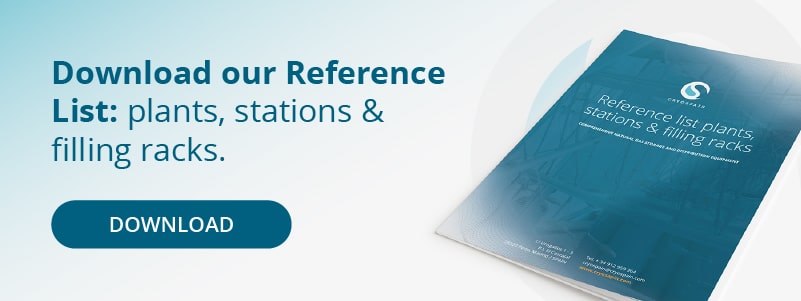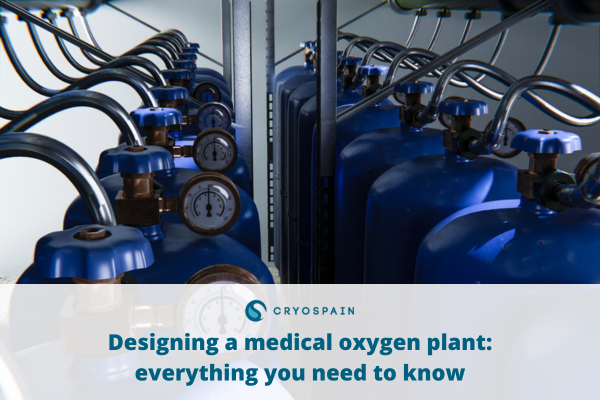Medical oxygen has become increasingly important over the years. With hospitals and other medical centres needing soaring quantities of this element, they’ve often gravitated towards ordering oxygen-filled bottles or tanks. However, for some centres, the benefits of producing their own medical oxygen through a medical oxygen plant have been more and more evident.
Whether the hospital faces a standard need for medical oxygen or experiences peaks in demand (such as emergency cases), the medical oxygen generator plant is ready for on-site delivery.
Thus, we discuss the details about designing and implementing a medical oxygen gas plant, which might be of interest for medical centres that need to count on a reliable source to continuously generate this elemental gas.
Why is medical oxygen important?
Uses of medical oxygen
Used for centuries as part of different therapies, medical oxygen nowadays remains a key component for many therapeutic processes:
- Helps easing respiratory distress or lack of breathing in life support and artificial ventilation cases, including first-aid resuscitation
- Provides a basis for the majority of anesthetic techniques
- Aids with heartbeat stability
- Helps in restoring tissues that present an oxygen tension. It thus provides an oxygen therapy such as those derived from serious trauma, respiratory or cardiac arrests or shocks, among others
- Assists in surgical procedures, such as cardiac surgery and patients with cardiac problems
Related content: Importance of liquid oxygen systems in the medical and pharmaceutical industry
Considering these uses, there are a handful of centres that might benefit from having immediate access to a medical oxygen plant, including Emergency Medical Services, hospitals and clinics, dental practices, ambulances, nursing homes or veterinary clinics, among others.
Medical oxygen vs industrial oxygen: the differences
- Uses: medical oxygen is part of medical treatments both for humans and animals; industrial oxygen, which is produced in industrial quantities, can play a part in different processes such as combustion, oxidation, and other chemical reactions.
- Composition: industrial oxygen does not subject to the same degree of purification and filtration as medical oxygen. The last one must guarantee a high purity. In fact, the European Directorate for the Quality of Medicines has established that any medical oxygen generator plant must guarantee a 93% purity (which can reach up to 95%) in order for it to be used safely. In the case of medical oxygen obtained through cryogenic methods, it must guarantee a 99% purity level.
This is achieved through medical oxygen cylinders, where contamination of other gases must not take place.
In order to do so, different regulatory bodies (for instance, the FDA in the U.S.A) require medical oxygen cylinders to verify their custody chain and secure that no impurities are present when filled with medical oxygen. Control and follow-up protocols must also be guaranteed.
In the case of industrial oxygen, this is less important and it’s possible for diverse impurities to appear with no associated risk.
- Requirements and rules: medical oxygen and any medical oxygen plant present specific requirements from diverse regulatory bodies. These rules are generally stricter in terms of quality and purity control compared to industrial oxygen.
Medical oxygen plant: designing process
A medical oxygen plant is an industrial system designed to generate oxygen that is fit for medical purposes.
An oxygen plant for a hospital or other medical facilities typically uses pressure swing absorption (PSA) technologies, membrane separation techniques or cryogenic techniques in order to separate different components from the atmospheric air it uses as feedstock. Thus, it eliminates humidity, bacteria and other elements, making medical oxygen possible in order to store it for future uses or feed a distribution system.
Keep reading: Why are liquid oxygen tanks so important? Uses and other important information
Equipment
The equipment needed for a medical oxygen generator plant or a medical oxygen cylinder filling plant typically includes:
- Storage tank
- High-pressure valves
- Cryogenic reciprocating pump
- Cryogenic atmospheric vaporizer
- Filling rack
- Vacuum insulated piping
Regulations
Regulations for medical oxygen stems from a number of regulatory bodies, both international and national.
In Europe, The European Industrial Gases Association (EIGA) is in charge of initiating the development of appropriate standards for medical oxygen, while also providing standardisation bodies with technological expertise.
At the same time, each country has its own standards, which can also vary if the medical oxygen presents a high pressure or not.
These include the RAP, ITC or EP6 regulations, among others.
Keep reading: Cryogenic liquid gases: differences and common uses of LNG, LIN, LOX, LAR and LC02
Cryospain’s expertise in designing a medical oxygen gas plant
At Cryospain we provide cryogenic engineering expertise in order to generate medical oxygen plants for hospitals and other medical facilities. We offer our experience to design and implement medical oxygen filling plants, either for liquid vessels or for compressed bottles.
Our success stories include the design and installation of a compressed medical oxygen plant for a partner in Vallecas, and the implementation of a liquid medical oxygen manufacturing plant in Arganda del Rey. Both of them proven to a reliable and efficient reference of medical oxygen.
Following our clients’ needs and requirements, we are able to design and implement turnkey installations that also guarantee safety and comply with all regulations. We work closely with out clients to understand their specific needs for design and implement a customized solution.











 Contacte-nos
Contacte-nos